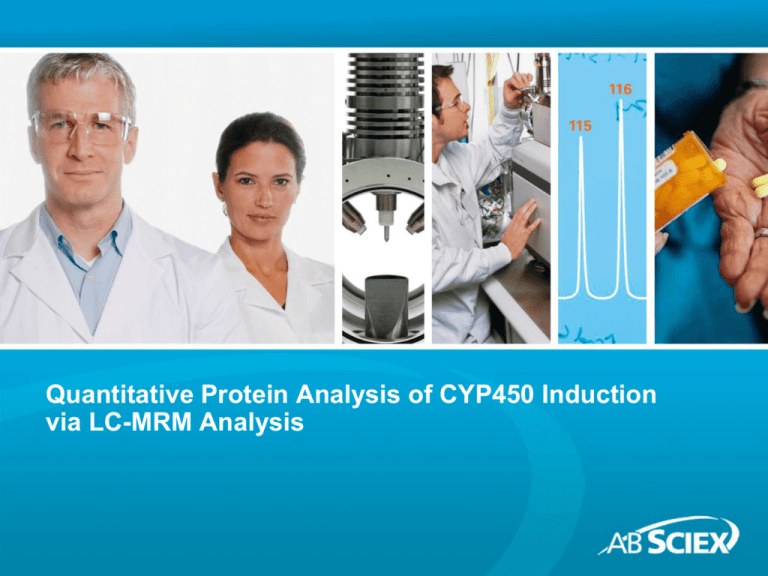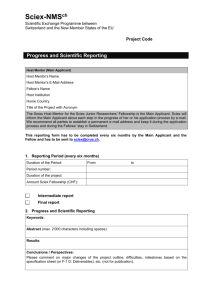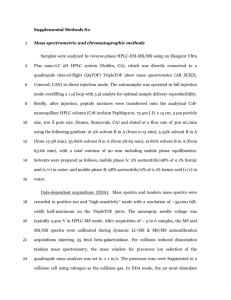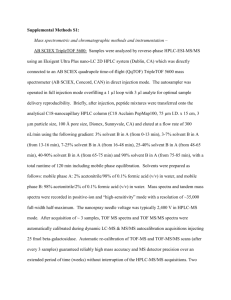
Quantitative Protein Analysis of CYP450 Induction
via LC-MRM Analysis
Cytochrome P450 Proteins
− Cytochrome P450 enzymes are mainly
expressed in liver and are responsible for
oxidative metabolism of drugs, environmental
pollutants, carcinogens, etc
− Cytochrome P450 Family of Enzymes
– 70 p450 protein families in humans
– Over 200 different subfamilies / isoforms
– Each isoform has different substrate specificities, varied inducibility by
different drugs
− Important in drug development
– Changes in expression of specific isoforms provide information on
toxicity of different drugs
– Individual patient basal expression levels affect responsiveness to drugs
2
© 2010 AB SCIEX
Human CYP Enzymes
Drug Metabolism
3
© 2010 AB SCIEX
Current Methodologies for Assessing CYP450
Induction
− mRNA techniques
– Measure the amount of messenger RNA expressed for each enzyme isoform
– Assesses only CYP induction from gene transcription changes
− Enzymatic activity
– Induction by quantifying the metabolite of a CYP-specific probe substrate
generated from treated hepatocytes
– Relies on the specificity of enzymatic conversion of probe substrates, and a
different probe substrate is required for each CYP isozyme which is not always
possible
− Western Blotting techniques
– Measures the actual protein levels of CYP450 enzymes using isoform-specific
antibodies. Currently there are only a few good antibodies that are isoform
specific
Major Challenges in Induction Assay:
Assay selectivity, and sensitivity; Different technical expertise and
equipment are needed for mRNA or Western Blotting assessment
4
© 2010 AB SCIEX
Expression
– Using commercially available
antibodies to the various subfamilies
of P450 proteins, Western Blot
analysis can be used to monitor
changes in protein expression
– However, commercial antibodies are
not available for all protein isoforms
– Some antibodies recognize multiple
isoforms
PB
induced
− Western Blot Analysis of p450
Control
Challenges of Current Approaches
Cyp1a1
Cyp1a2
Cyp2e1
− An MS-based approach could
provide sensitivity and specificity
through the detection of individual
peptides from specific P450 isoforms
Cyp3a4
Changes in expression in response to
treatment with phenobarbitol
5
© 2010 AB SCIEX
CYP Induction Assay: LC-MS/MS Solution
− An LC-MS/MS-based approach can provide sensitivity and specificity
through the detection of individual peptides from specific CYP450
isoforms
− A fast MS scan speed and the Scheduled MRM™ Algorithm allows
for multiplexed protein quantitation
− A CYP450 protein assay kit including all reagents, sample
preparation procedure and established LC/MS/MS conditions
provides easy protein quantitation for human induction studies using
current DMPK resources
6
© 2010 AB SCIEX
Multiple Reaction Monitoring (MRM)
Mass
Analyzer
Select Peptide
Fragmentation
Cell
Fragment
peptide
Mass
Analyzer
Select Fragment
Detector
Detect Fragment
− Highest specificity and sensitivity for detecting components in a
complex mixture
− Requires QTRAP® System or triple quadrupole MS capability
− Largest linear dynamic range for quantitation
− Well accepted as the MS technique for quantitation (Pharmaceutical
Industry)
7
© 2010 AB SCIEX
Sample Preparation for LC/MS/MS Analysis of
Protein Therapeutics
− Problem: Protein therapeutics and larger peptide therapeutics are
typically too large to directly quantitate using standard MRM assays
in mass spectrometry
− Solution: Enzymatically digest the protein or large peptide
therapeutic into small peptides and monitor one or more peptides as
a surrogate
– Trypsin is the enzyme of choice for several reasons:
– Tryptic peptides are a good size for MRM assays (not too large)
– Tryptic peptides tend to fragment well leading to good MRM assays
– Trypsin digest quality can be very good when a high grade of trypsin is used
Protein
Peptides
Enzyme
(Trypsin)
8
© 2010 AB SCIEX
Quantifying Proteins by Multiple Reaction
Monitoring
Intact
protein
Peptide
fragments
MS/MS – Q3 m/z
Peptide Q1 m/z
Enzyme Trypsin
* *
**
0
MRM Method
200
400
600
m/z
800
MRM Results
Stable Isotope Labeled
Internal Standards
9
© 2010 AB SCIEX
General Strategy for Protein Quant using SIS
Peptides
COOH
Sequence of Target
Protein in sample
Generate a list of
peptides that uniquely
identify each p450
isoform.
H2N
..RQLYSLVGITK..
…RYILNDAVEIR…
…KLQISSDVLAR…
Synthesize each of
these peptides with a
heavy amino acids
RQLYSLVGITK*
RYILNDAVEIR*
KLQISSDVLAR*
MRM LC/MS/MS
Internal Std
Design MRM method –
monitor heavy and
light peptides
Target
Area of target
* [ Int. Std. ]
Area of Internal std
10
= Concentration
of target protein
© 2010 AB SCIEX
P450 Peptide Assay Workflow
Control
Microsomes
Induced
Microsomes
Synthetic heavy peptides
Reduce
Alkylate
Trypsin digest
1D LC-MRM
20 min run
[Peak Area Smp/
Peak Area Std]
*CStd
Concentration of
control P450
11
Reduce
Alkylate
-representative of each P450 studied
-for internal standard and concentration curve
Mix
Mix
Trypsin digest
1D LC-MRM
20 min run
[Peak Area Smp/
Peak Area Std]
*CStd
Concentration of
induced P450
© 2010 AB SCIEX
Scheduled MRM™ Algorithm
Improving MRM Method Efficiency by Maximizing Analyte Utilization
−
−
−
−
−
12
Each MRM monitored only across its expected elution time
concurrent MRMs
Maintain cycle time and dwell time
effective duty cycle for every peptide
Maintain analytical precision
© 2010 AB SCIEX
LC-MRM Assay of CYP Proteins
− High assay
CYP 1A2
robustness
through
monitoring
CYP 2B6
– Multiple
MRMs per
peptide
– Multiple
peptides per
protein
3A5 -Pep 2
3A5 -Pep 3
3A5 -Pep 1
1A2 -Pep 3
CYP 3A4
CYP 3A5
3A4 -Pep 1
1A2 -Pep 2
2B6 -Pep 2
1A2 -Pep 1
3A4 -Pep 2
2B6 -Pep 3
2B6 -Pep 1
3A4 -Pep 3
13
© 2010 AB SCIEX
How Consistent are MRMs to each Peptide
2B6 Peptide 3
35
30
fmol on column
25
20
MRM 1
MRM 2
MRM 3
15
10
5
0
1mg/mL
1mg/mL11mg/mL 2mg/mL
2mg/mL
3mg/mL 33mg/mL
Sample
Sample
2 2mg/mL 3mg/mL
Sample
14
© 2010 AB SCIEX
Peptide Consistency for CYP 1A2
160
140
fmol on column
120
Peptide 1
100
Peptide 2
80
Peptide 3
60
40
20
0
Sample
1mg/mL 1
15
Sample
2
2mg/mL
Sample
3 mg/mL 3
© 2010 AB SCIEX
Typical Western Blot Data from Induction Study
− The typical results seen in Western blot analysis of
protein expression correlates with the observed LC/MS
results
16
© 2010 AB SCIEX
XIC of (a) control and (b) 3-MC induced microsomes for
the one of the peptides from Cyp1A2.
(a) Control Sample
(b)
3-MC Induced
Sample
Sample
Sample
Standard
Standard
17
© 2010 AB SCIEX
LC-MS/MS Protein
All Cytochrome P450 Proteins
− Adding CYP3A5 data relative to
other CYPs
– Protein expression changes
illustrate 3A5 is inducible
– 3-MC – minimal induction of
3A5
– (PB) – Significant induction of
CYP3A5
– (RIF) – Small induction
CYP3A5
21
© 2010 AB SCIEX
Conclusions - CYP Induction Assay
LC-MS/MS Protein Expression Analysis
− Highly sensitive, specific, and fast Multiple Reaction Monitoring
(MRM) method has been developed:
– 12 different peptides representing 4 unique P450 proteins (CYP 1A2,
2B6, 3A4 and 3A5) were simultaneously monitored and quantified
– 2B6, a lower abundant CYP, is easily detected showing good dynamic
range of method
− Largest protein expression change was observed for microsomes
prepared from RIF induced hepatocytes – Cyp3A4 showed an
increase in expression upon drug treatment of ~50-fold over control.
– S9 or microsomal subcellular fractions can be used
− This method was in excellent agreement with existing methods
(mRNA, enzyme activity assays)
23
© 2010 AB SCIEX
Human Induction Kit (100 Assays)
Starter Kit Contents
− Heavy peptide mix
− Denaturant, Reducing reagent, Alkylating reagent
− Digestion buffer
− Trypsin
− Peptide column
− Acquisitions methods for
– AB SCIEX Triple Quad™ 5500 and QTRAP® 5500 systems
– API 4000™ system, 4000 QTRAP® system, API 5000™ system
− Quantitation methods for MultiQuant™ software 1.2
− Microsoft Excel 2007 results template
24
© 2010 AB SCIEX
Acknowledgements
− AB SCIEX
– Sean Seymour
– Christie Hunter
– Lydia Nuwaysir
− CellzDirect
– Jeanette Hill
– Rob Taylor
25
© 2010 AB SCIEX
Thank You for your Attention
Trademarks/Licensing
− For Research Use Only. Not for use in diagnostic
procedures.
− The trademarks mentioned herein are the property of
AB Sciex Pte. Ltd. or their respective owners. AB
SCIEX™ is being used under license.
− © 2010 AB SCIEX. All rights reserved. Information
subject to change without notice.
27
© 2010 AB SCIEX







